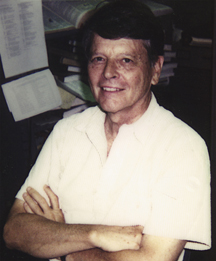![]()

We, the scientists of Leg 191, wish to express our appreciation to our good friend and colleague, Ralph Moberly, for his contributions to our cruise and his long dedication to ocean drilling and marine geology of the Pacific. Ralph is not retiring just yet, but he has admitted it will not be far in the future, and Leg 191 may or may not be his last cruise (sometimes he says it will be, but we hope not). Nevertheless, we take this opportunity to recognize the accomplishments of a fine scientist and true gentleman. When you work with him for months at sea, the things you notice about Ralph are his extensive knowledge of geology and sedimentology (and many other things, for that matter), his keen eye for detail, his understated wit, and his self-effacing manner. As a scientist on our team, we could ask for none better; as a human being, we could ask for none more genuine.
Ralph Moberly was a key player in the Deep Sea Drilling Program (DSDP) sampling of the western Pacific Ocean. He sailed as a scientist on Legs 7, 17, and 61 and as co-chief scientist on Legs 32 and 89, investigating the distribution of sediments and Cretaceous volcanics in the western Pacific. From 1988 to 1990, he was chairman of the JOIDES Planning Committee and head of the JOIDES office during its stay at the University of Hawaii. In the past two decades, Ralph has spent his time serving in a number of administrative roles and as chair, as well as guiding the University of Hawaii Geology and Geophysics Department from 1990 to 1993 and the Ocean Engineering Department from 1995 to 1998. Previously, he served as chair of the Geology and Geophysics Department from 1964 to 1965 and 1975 to 1980 and was associate director of the Hawaii Institute of Geophysics from 1983 to 1990.
Ralph’s love affair with the sea began with the U.S. Navy in 1950. As a lieutenant junior grade, he worked in oceanographic surveying until 1953. After obtaining his Ph.D. at Princeton in 1956, where he worked with Harry Hess, Ralph did a brief stint with Standard Oil in California before being hired as the third faculty member in the University of Hawaii’s Geology Department in 1959. During the 1960s, he completed a pioneering study of Hawaiian shorelines and sand reservoirs as well as studies of basalt weathering products and their conversion into marine muds. His first DSDP cruise, Leg 7, set sail a few months before the end of that decade. During the 1970s, Ralph was one of the first to apply the concepts of the then-new global tectonics theory to the western Pacific in an article titled "Origin of lithosphere behind island arcs, with reference to the western Pacific." His interest in active margin tectonics continued with his participation in the IDOE Nazca project in the early 1970s. Through the decade, he participated in DSDP Legs 17, 32, and 61. Active margins kept Ralph’s interest through the 1980s, during which he published studies on forearc basins in Peru, Ecuador, and Chile and the structure and tectonics of the continental margin of Peru. During 1982, he was co-chief scientist on DSDP Leg 89. Since then, his work on Pacific geology has continued as his engagement in administrative endeavors have increased.
As he nears the close of a noteworthy career, we wish to recognize Ralph for his unselfish service to the ocean drilling community, marine geology, his university, and his students. He is one of those unsung heroes who made a difference but did not seek the spotlight. He is also a friend for whom we will always harbor fond memories.